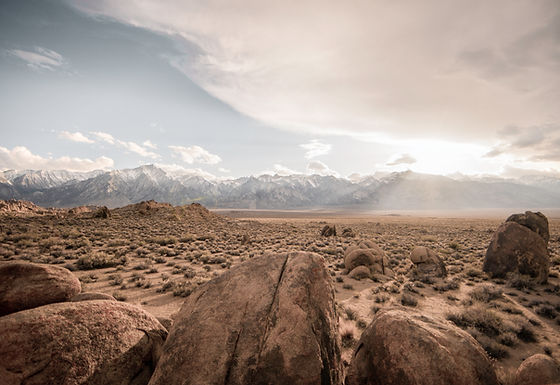
The Manzanar Committee
The Manzanar Committee is a Southern-California-based organization committed to raising awareness of the unlawful incarceration of the Japanese and Japanese Americans during World War II. In addition to a wealth of resources, an annual pilgrimage to the Manzanar National Historical Site, and facilitating an ongoing discussion through a variety of events and media, the Manzanar Committee also encourages young people to join the education effort.
The Sue Kunitomi Embrey Awards invites students of all ethnicities to share their perspectives on social justice through creative means. See Kaia's 2022 submission below.
Artist's Statement
Kaia's 2022 submission to the SKE Awards

In this piece, I wanted to start a conversation about the origins and lingering impact of Japanese internment* camps during World War II. The red sun in the background is meant to represent the rising sun of the Japanese flag, set beyond the horizon. Behind the sun is the pledge of allegiance repeated over and over again. In front of the bird are large brown masses of dust clouds; with this, I specifically wanted to represent the conditions at Manzanar as I had experienced them in my own pilgrimage to the site with my parents a few years ago. Despite only visiting for a few hours, I became sick due to the dry air and dust, which was prevalent no matter where you stepped. Knowing that I was only there for a few hours and had a sore throat that lasted a week, I couldn’t imagine what actually living there was like. Finally, the centerpiece of the art is a Japanese crane trapped in barbed wire painted in the colors of the American flag, representing the Issei and American-born Japanese who were incarcerated and forced into the camps. I made the crane the focal point of the image because the population of Japanese cranes in Hokkaido never leave their home—yet others of the same species migrate to other states, provinces, and countries. This reflects the diaspora of the Japanese—and members of my family in particular, who are spread out from Sapporo to Hawaii to Los Angeles, where I live with my family.
Now why is the crane tied up in colorful barbed wire, and what does this have to do with the motivations behind the internment camps? Pre-internment, Japanese Americans faced a great deal of racism despite being born in America or naturalized as official American citizens. Anti-Japanese propaganda was spreading across the nation, with the goal of sending “Japs” back to their country. The racism worsened during WWII as Japan sided with Germany. After Japan bombed Pearl Harbor, racism towards Japanese Americans reached a fever pitch. Then in 1942, FDR issued an executive order that forced Japanese Americans into internment camps to reduce the risk of Japanese espionage, despite the fact that many of the people sent to the camps were born in America. It was clear that America only created these internment camps to further alienate both Japanese immigrants and Japanese Americans. The red-white-and-blue barbed wire around the crane is inspired by Bob Matsumoto’s “Remembrance,” and represents how the American government attempted to control the Japanese population during WWII and to push racist ideologies onto the American public.
The Pledge of Allegiance, instilled in me beginning in elementary school, is repeated incessantly in the background, representing America’s preaching of patriotism to the government and loyalty to the flag as a symbol of our country. I’ve always found it disquieting that no matter what race you are—White, Asian, Black, or Hispanic—the idea of patriotism is drilled into us at a young age, in spite of the injustices our ancestors may have suffered at the hands of the government. The American government specifically betrayed Japanese Americans by incarcerating them illegally, justifying their actions by claiming the incarcerees could be “spies”—in spite of the suppressed Munson Report that found Japanese Americans to be loyal to their country. The sun, which is “rising” on the Japanese flag, can also be seen as sinking beyond the horizon in the art work, representing the lost hope of Japanese Americans responding to these promises and disillusions. Many Japanese Americans remained, but many also ended up leaving America, giving up on their country.
Despite these terrible conditions, the majority of Japanese Americans persevered. In spite of being betrayed by their government, many were willing to fight for their country in World War II. The 442nd Regimental Combat Team was a segregated unit dedicated to Japanese American soldiers. Most soldiers of the 442nd were Nisei, second generation immigrants. Back at home, the community made the most of their incarceration, planting gardens, initiating baseball tournaments, and continuing to practice their own religions.
My great grandfather was a Buddhist minister who was singled out as a community leader in Hawaii, which did not forcibly remove all Japanese due to their sheer number. Shortly after his removal, he was sent to the hospital for having contracted tuberculosis, while my great-grandmother remained on the plantation where they lived to continue to provide spiritual guidance to the workers. Without their perseverance, I wouldn’t be alive today.
Kaia Noelani Heiberg
*Note that "concentration camp" is the less euphemistic, more accurate term. Find out why.
